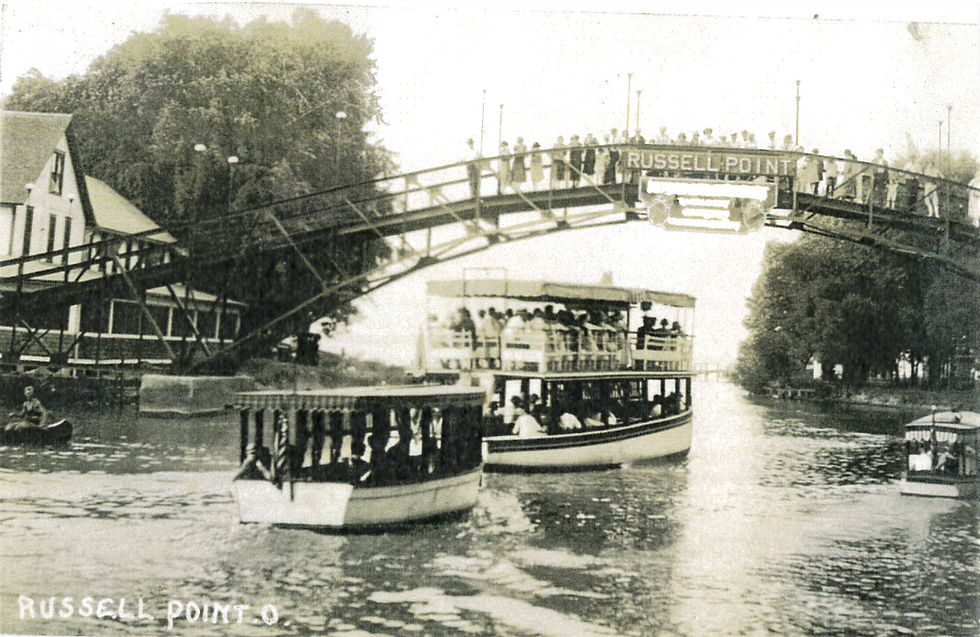George Wood Anderson
- Mary Mortimer

- Jul 18
- 3 min read
Belle Center native George Wood Anderson was a noted pastor and evangelist. For many years, he held large multi-week revival meetings that attracted thousands of people in Logan County, other parts of Ohio, and several other states. He was also one of the top speakers at the Chautauqua and Lyceum lecture series starting in the early 1900s.
Anderson was born in 1873 in Belle Center to Calvary B. and Margaret L. Zupp Anderson. Mr. Anderson owned a carriage shop and sadly died while George was a young boy. After his father’s death, George took over the responsibilities of the family. He schooled himself and worked as a clerk at Blair’s Grocery, Emery & Company’s Hardware, and the Belle Center Herald to help support his mother and himself.
After completing the high school courses, Anderson attended a college in Dayton, and then at Taylor University in Indiana. He graduated from Ohio Wesleyan with a Bachelor of Arts and Master of Arts in 1899, and earned a Doctor of Divinity in 1912, after which he became a minister.
Anderson began his most popular lecture, “Baldheads Outside and In” in about 1900. He traveled around the state speaking at a variety of lecture series. His other lectures included Wisdom of Foolishness, Michael Angelo, and The Swordless Crusader.
He served at churches in Lima, Ohio, St. Louis, Missouri and Scranton, Pennsylvania before moving to Troy, New York. There he met Miss Nellie Josephine Sharpe, an accomplished musician who had studied piano under renowned pianist and teacher Raphael Joseffy.
Anderson and Sharpe married in August 1912 in Albany, New York. After their marriage, they moved to Logan County and purchased a 124-acre chicken farm near Belle Center where they had about seven hundred chickens.
In August 1915, Anderson decided to build upon his Chautauqua audiences and conduct a six-week Union Evangelistic Tabernacle Campaign in Logan County. He worked out a deal with the Logan County Lumber Company to rent lumber for the tabernacle at a rate of $6.00 per thousand feet, rather than buy it. The agreement also stated Anderson would pay for any lumber that was damaged during construction and dismantling the tabernacle.
Anderson built a tabernacle in Rutan Park in Bellefontaine that measured 107’ x 156’ and could hold 3,800 worshippers. The tabernacle had electricity even though it was a temporary structure. It had hundreds of wooden chairs behind the pulpit and rows of wooden benches for the worshippers. The aisle floors were covered in sawdust leading to the nickname “The Sawdust Trail.”
The Union Evangelistic Tabernacle Campaign in Rutan Park ran from September 12th through October 24th, 1915. Anderson built a similar tabernacle in Belle Center. It was reported that the local churches received many new members after Anderson’s Union Evangelistic Tabernacle Campaign. The success of his tabernacles stemmed from his ability to capture his congregations’ attention with his storytelling, humor, and charisma. His sermons were said to be “pure, pleasing, and polished.” Anderson’s multi-day lectures were attended by more than 6,000 people.
In 1917, Anderson made the decision to travel to France to aid U.S. soldiers serving in WWI. On the Sunday before he left, Anderson preached a goodbye sermon at churches in Bellefontaine and Kenton. The churches were crowded with friends of the evangelist who came to wish him well. A total of $1,200 was donated by the congregations for the soldiers.
Also accompanying Anderson to France was Dow Bancroft and Lawrence Zupp, a sophomore at Huntsville High School who temporarily withdrew from school for the trip. Zupp would later go on to be an attorney and judge in Logan County. On September 1, 1917, the trio boarded a ship for France to serve with the Y.M.C.A
While in France, Anderson wrote letters to the families of those serving in the war. His letters to family started with, “while in France I had the pleasure of meeting your son, (their name), who gave me your address that I might be able to send you a short message. He was nicely located and in fine health and spirits. He, with other soldier boys, has plenty to wear and to eat and is safely sheltered. Our government is doing everything possible to safeguard the health and morals of our boys in France and they are the best cared for soldiers in the world.” After serving nine months, Anderson, Bancroft, and Zupp returned to the US, and Anderson resumed his lectures.
Starting in 1921, Anderson began annual transcontinental trips where he held United Gospel Crusades. He became editor in chief of The Clergyman’s Research Letter and president The Religious Research, incorporated in 1940. He was also an accomplished musician, hymn writer and author. His most popular book “Unfinished Rainbows” is a collection of essays that provide inspiration and challenge readers to deepen their Christian faith.
George and Nellie Anderson retired to New York City where they spent the rest of their lives.

























Comments